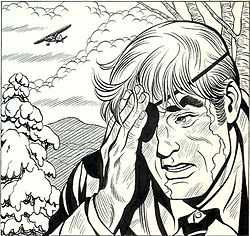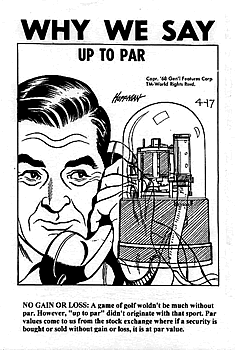Pete Hoffman
| Pete Hoffman | |
|---|---|
| Born | February 22, 1919 |
| Died |
September 7, 2013 (aged 94) Toledo, Ohio |
| Nationality | American |
| Area(s) | Cartoonist |
Notable works |
Steve Roper and Mike Nomad Jeff Cobb |

Pete Hoffman (February 22, 1919 - September 7, 2013) was an American cartoonist.[1] He is known for his work on the adventure strips Steve Roper (later Steve Roper and Mike Nomad) and Jeff Cobb.
Biography
Early years
Born in Toledo, Ohio, the youngest of four children, Hoffman showed artistic talent in his boyhood.[2] He attended the University of Toledo, where he majored in advertising and marketing but also did editorial and commercial cartooning.
World War II
Graduating in 1941, Hoffman served in the U.S. Army Air Corps during World War II. Afterwards, he returned to Toledo and stopped by to see Steve Roper authors Allen Saunders and Elmer Woggon; he had met them as a student cartoonist and had been sending them additional sketches during the war.[3] Liking his work, Saunders then hired him as a new ghost for Woggon because Publishers-Hall Syndicate had complained that the artwork still looked too cartoonish for an adventure strip.[4] To judge by the change in drawing style, Hoffman began in December 1945, and yet the strip continued to appear as "Steve Roper by Saunders and Woggon." Hoffman's name was seen in it just once (June 9–14, 1947) — when Roper's friend Sonny Brawnski wrestled "Poison Pete Hoffman" after threatening to throw him into Toledo's Maumee River.
"Giving up the ghost"
Hoffman gave the postwar Steve Roper the more serious, consistent look it needed as it settled into a modern urban setting. He portrayed the main characters engagingly, and realistically showed them maturing in their lives and careers. (His villains, on the other hand, were grotesque or deformed, as in Dick Tracy.) In a later interview,[2] he modestly understated his contribution: "The strip was in a transition stage and a more illustrative style of drawing was desired. My style fit their needs. I enjoyed ghost-drawing the characters for nearly nine years." The ghost was no secret, however: a 1953 article on Steve Roper in the Toledo Blade described Hoffman's role in the strip and pictured him working with Saunders and Woggon in their studio. At that time, ghosting was regarded as a new artist's apprenticeship until he could start his own strip. And following the two previous Steve Roper ghosts — Elmer Woggon's younger brother Bill Woggon (Katy Keene) and Don Dean (Cranberry Boggs)—Hoffman did just that in mid-1954, leaving Steve Roper to produce his own strip, Jeff Cobb. The parting was amicable, and Saunders and Woggon sponsored him when he joined the National Cartoonists Society in 1955. Starting with the July 12, 1954 strip, his replacement on Steve Roper was William Overgard, who put an end to the ghosting and boldly signed his artwork.
Jeff Cobb and Why We Say

Jeff Cobb debuted on June 28, 1954, both written and drawn by Hoffman and distributed by General Features Syndicate. As Hoffman said in a later interview,[2] "Hopefully, some of Allen Saunders' expertise rubbed off on me when I worked on Steve Roper." Indeed, Cobb could have been a blond clone of Roper circa 1952, except that he didn't smoke a pipe and wore a black eye-patch after losing his right eye in a roof cave-in the 1960s. (It actually made him more popular.) Also like Roper, Cobb was an attractive, clean-cut, two-fisted investigative reporter (working for the Daily Guardian) who defended his standards, fought crime, and endured near-fatal threats to his life; he had to, "to keep his creator eating regularly".[3] On the other hand, Hoffman's Jeff Cobb developed a greater range of expression and a more mature level of fine-line photorealism than his Roper. Like Saunders, he also emphasized characterization in plot development,[3] and said he never ran out of ideas: the well-written stories were inspired by newspaper articles he read, and characters were often based on real people.[2] Jeff Cobb developed a loyal following of readers in the U.S. and abroad, especially in Sweden.
During this same period, Hoffman illustrated the single-panel feature Why We Say (1950–78), which was written by Robert Morgan and explained word and phrase origins in laypersons' terms.
Later career
When Jeff Cobb' ended in 1975, "a victim of the phase-out" of newspaper continuity strips in general,[3] Hoffman turned to freelance work and University of Toledo alumni projects.
Honors
Hoffman continued to live in his native Toledo, and in 2004, on the 50th anniversary of Jeff Cobb, he was honored there by appreciative fans—and by a collection of fellow cartoonists' caricatures, each sporting a Jeff Cobb eye-patch.[4]
Personal life and death
Hoffman never married, regarding himself as "married to the drawing board".[5]
Hoffman died of a heart attack, aged 94.[1]
References
Notes
- ↑ 1.0 1.1 "Pete Hoffman; 1919-2013: Toledo cartoonist syndicated worldwide". Toledo Blade. Retrieved 2013-09-14.
- ↑ 2.0 2.1 2.2 2.3 Karlen, Dave. Interview with Pete Hoffman, 2004.
- ↑ 3.0 3.1 3.2 3.3 Labuzinski, Randy. "Cartoonist Draws upon Experience," by Randy Labuzinski. Toledo Blade, August 19, 1986, p. 6.
- ↑ 4.0 4.1 Black, Ed. "Jeff Cobb Hits 50!" The Glyph—Great Lakes NCS Newsletter, 2004
- ↑ Shirk, Barbara. "Pete Hoffman—Biographical Sketch". University of Toledo (Ward M. Canaday Center), 1992.
Sources
- Rothman, Seymour. "Evolution of a Comic Strip," Toledo Blade, Pictorial, August 9, 1953, p. 5-6; reprinted in Steve Roper and Wahoo, Blackthorne Publishing (Book 2).
External links
|